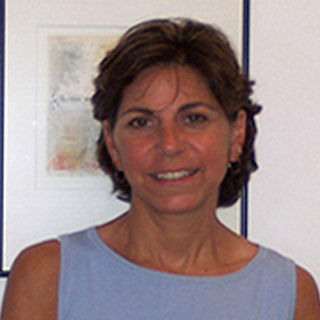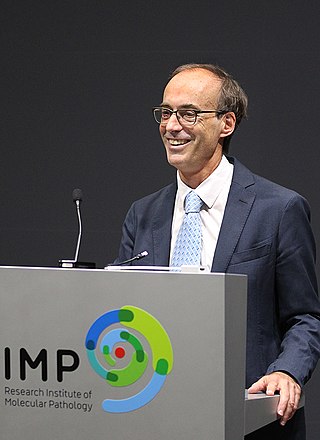Related Research Articles

Bruce Michael Alberts is an American biochemist and the Chancellor’s Leadership Chair in Biochemistry and Biophysics for Science and Education, emeritus at the University of California, San Francisco. He has done important work studying the protein complexes which enable chromosome replication when living cells divide. He is known as an original author of the "canonical, influential, and best-selling scientific textbook" Molecular Biology of the Cell, and as Editor-in-Chief of Science magazine.
Lawrence S.B. Goldstein is a professor of cellular and molecular medicine at University of California, San Diego and investigator with the Howard Hughes Medical Institute. He receives grant funding from the NIH, the Johns Hopkins ALS Center, the HighQ Foundation, and the California Institute for Regenerative Medicine. In 2020 he was elected to the National Academy of Sciences.
Joel Rosenbaum is a professor of cell biology at Yale University.

Elaine V. Fuchs is an American cell biologist famous for her work on the biology and molecular mechanisms of mammalian skin and skin diseases, who helped lead the modernization of dermatology. Fuchs pioneered reverse genetics approaches, which assess protein function first and then assess its role in development and disease. In particular, Fuchs researches skin stem cells and their production of hair and skin. She is an investigator at the Howard Hughes Medical Institute and the Rebecca C. Lancefield Professor of Mammalian Cell Biology and Development at The Rockefeller University.
Brigid L. M. Hogan FRS is a British developmental biologist noted for her contributions to mammalian development, stem cell research and transgenic technology and techniques. She is currently a Professor in the Department of Cell Biology at Duke University, Born in the UK, she became an American citizen in 2000.
Thomas Dean Pollard is a prominent educator, cell biologist and biophysicist whose research focuses on understanding cell motility through the study of actin filaments and myosin motors. He is Sterling Professor Emeritus of Molecular, Cellular & Developmental Biology and a professor emeritus of cell biology and molecular biophysics & biochemistry at Yale University. He was dean of Yale's Graduate School of Arts and Sciences from 2010 to 2014, and president of the Salk Institute for Biological Studies from 1996 to 2001.

Diane L. Barber is an American cell biologist. She is an Endowed Professor and Chair of the Department of Cell and Tissue Biology at University of California, San Francisco (UCSF) and an elected American Association for the Advancement of Science fellow in recognition of her "distinguished contributions on cell signaling by plasma membrane ion transport proteins and on the design and function of proteins regulated by intracellular pH dynamics." In addition to teaching graduate and professional students and her administrative service, she directs a research laboratory funded by grants from the National Institutes of Health (NIH) and the National Science Foundation (NSF).
James A. Spudich is an American scientist and professor. He is the Douglass M. and Nola Leishman Professor of Biochemistry and of Cardiovascular Disease at Stanford University and works on the molecular basis of muscle contraction. He was awarded the Albert Lasker Basic Medical Research Award in 2012 with Michael Sheetz and Ronald Vale. He is a Fellow of the American Academy of Arts and Sciences and a Member of the National Academy of Sciences.

Ronald David Vale ForMemRS is an American biochemist and cell biologist. He is a professor at the Department of Cellular and Molecular Pharmacology, University of California, San Francisco. His research is focused on motor proteins, particularly kinesin and dynein. He was awarded the Canada Gairdner International Award for Biomedical Research in 2019, the Shaw Prize in Life Science and Medicine in 2017 together with Ian Gibbons, and the Albert Lasker Award for Basic Medical Research in 2012 alongside Michael Sheetz and James Spudich. He is a fellow of the American Academy of Arts and Sciences and a member of the National Academy of Sciences. He was the president of the American Society for Cell Biology in 2012. He has also been an investigator at the Howard Hughes Medical Institute since 1995. In 2019, Vale was named executive director of the Janelia Research Campus and a vice president of HHMI; his appointment began in early 2020.
Laszlo Lorand was a Hungarian-American biochemist who studied clotting of blood and other bodily fluids. A professor emeritus in cell and molecular biology at the Feinberg School of Medicine, Lorand was a longtime professor in the departments of chemistry and molecular biosciences at Northwestern University before transferring to Northwestern's medical school. Lorand was a co-discoverer of the substance that later became known as factor XIII. He was a member of the National Academy of Sciences.

Gary G. Borisy is a retired president and director of the Marine Biological Laboratory in Woods Hole, Massachusetts. In 2013, Borisy joined the Department of Microbiology at the Forsyth Institute.
Janet Iwasa is an American data visualization expert and assistant professor of biochemistry at the University of Utah.
Wyndham Willoughby Lathem is an American microbiologist and convicted murderer. He is a former associate professor at Feinberg School of Medicine at Northwestern University, a specialist in pathogenic bacteria.
Karen Oegema is a molecular cell biologist at the Ludwig Institute for Cancer Research and a professor of cellular and molecular medicine at the University of California, San Diego. She is best known for her research with Caenorhabditis elegans, which her lab uses as a model system in their mission to dissect the molecular mechanics of cytokinesis. She was given the Women in Cell Biology Mid-Career Award for Excellence in Research in 2017, as well as the Women in Cell Biology Junior Award for Excellence in Research in 2006.

Daniel Alfonso Colón-Ramos is the McConnell Duberg Professor of Neuroscience and Cell Biology at Yale University School of Medicine, where his lab studies the cell biology of the synapse during development and learning. He is also the founder of the nonprofit organization Ciencia Puerto Rico (CienciaPR), a collaborative network for people interested in science and Puerto Rico. In 2020, he was named to the National Academy of Medicine.
Milan Mrksich is an American chemist. He is the Henry Wade Rogers Professor of biomedical engineering at Northwestern University and has additional appointments in chemistry and cell and developmental biology. He also serves as both the founding director of the center for Synthetic Biology and as an associate director of the Robert H. Lurie Comprehensive Cancer Center at Northwestern. Mrksich also serves as the Vice President for Research of Northwestern University.

David R. Gius is an American physician-scientist the Zell Family Scholar Professor, Women's Cancer Research Program director, and Vice Chair of Translational Research at Northwestern University's Feinberg School of Medicine Department of Radiation Oncology and Pharmacology. His research focuses into the mechanistic connection between aging, cellular and/or mitochondrial metabolism, and carcinogenesis focusing on the Sirtuin gene family.
Edwin W. Taylor is an adjunct professor of cell and developmental biology at Northwestern University. He was elected to the National Academy of Sciences in 2001. Taylor received a BA in physics and chemistry from the University of Toronto in 1952; an MSc in physical chemistry from McMaster University in 1955, and a PhD in biophysics from the University of Chicago in 1957. In 2001 Taylor was elected to the National Academy of Scineces in Cellular and Developmental Biology and Biochemistry.
Kathleen J. Green is a cell biologist whose research focuses on how cell-cell communication drives tissue form and function. She is the Joseph L. Mayberry Professor of Pathology and Toxicology and Professor of Dermatology at Northwestern University Feinberg School of Medicine in Chicago. She also serves as Associate Director of Basic Sciences at the Robert H. Lurie Comprehensive Cancer Center of Northwestern University.
References
- 1 2 "The Lawrence Ellison Foundation | Fostering creativity in biomedical research". www.ellisonfoundation.org.
- 1 2 "Faculty Profile: Robert Goldman, PhD". Feinberg School of Medicine. Northwestern Medicine. Retrieved 5 April 2017.
- 1 2 3 4 "1993 Bob Goldman" (PDF). ASCB.
- ↑ Goldman, Robert D. (1963). An investigation of growth-inhibiting substances produced by Kirchnerielle subsolitaria, a green alga. Thesis (M.S.)--University of Vermont, 1963.
- ↑ "Graduate Alumni Records -- Graduate Degrees Earned -- Robert D. Goldman". Princeton University Library. Retrieved 28 April 2019.
- ↑ "My NCBI Collections - MyBibliography" . Retrieved 31 July 2017.[ dead link ]
- ↑ Goldman, Robert D; Spector, David L; Swedlow, Jason R, ed. (2009). Live cell imaging a laboratory manual (2. ed.). Cold Spring Harbor, NY: Cold Spring Harbor Laboratory Press. ISBN 978-0879698935.
{{cite book}}:|first3=has generic name (help)CS1 maint: multiple names: authors list (link) - ↑ "NIH MERIT awards".
- ↑ "AAAA Elected Fellows".
- ↑ "ASCB Presidents". American Society for Cell Biology. Retrieved 5 April 2017.
- ↑ "Utländska ledamöter" (PDF) (in Finnish).
- ↑ NIHOD (27 September 2018). "A Tribute to Dr. Robert Goldman from NIH Director Dr. Francis Collins". YouTube. Retrieved 28 April 2019.
- ↑ Williams, Anna (28 September 2018). "Celebrating the Scientific Career of Robert Goldman". News Center. Retrieved 28 April 2019.